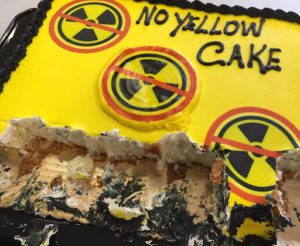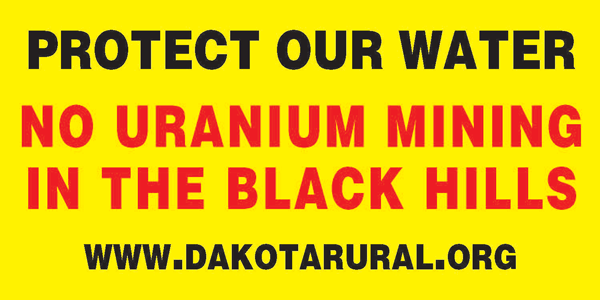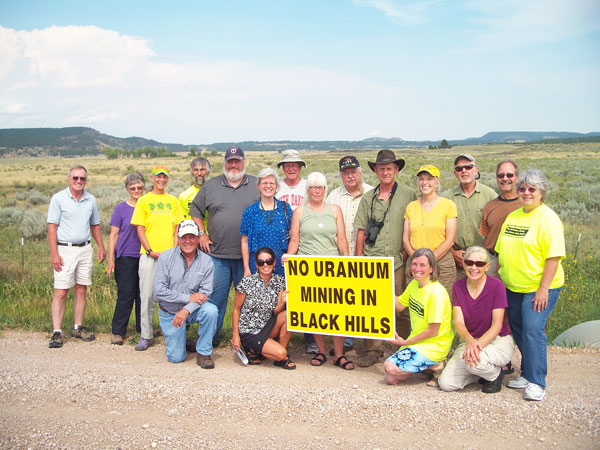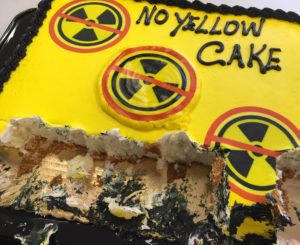Uranium Mining
 SAVE THE DATE : WED. OCTOBER 6TH POWERTECH URANIUM HEARING IN PIERRE
SAVE THE DATE : WED. OCTOBER 6TH POWERTECH URANIUM HEARING IN PIERRE
-
DRA is seeking donations to help get people *safely* to the hearing & cover costs of transportation, lodging, masks and food.
On October 6th, the State Water Management Board (WMB) will consider Powertech USA’s motion to resume their water permit & ground water discharge permitting processes for their proposed In Situ Leach uranium mine in Custer and Fall River Counties. (What is In Situ Leach mining?)
Those processes were put on hold in 2013 so that Powertech could pursue their federal permits–and those permits are still not finalized. While remote participation will be an option during this hearing, DRA and allies will also be making an effort (following COVID safety protocols) to fill the hearing room in Pierre to demonstrate strong public opposition to allowing this process to move forward. You do not have to be an intervenor to attend–ALL concerned citizens should plan to make their position known!
THIS IS YOUR CALL TO ACTION:
1.) First, Please Sign-On to our Letter to the South Dakota Water Management Board and please share with your family, friends, and networks.
SIGN-ON LETTER HERE
2.) Next, join us in Pierre on Oct. 6th (maybe the 7th) to let the Water Management Board know that we will continue to resist attempts to mine radioactive, toxic uranium. The mining would be temporary (about 20 years), but water and land pollution would be permanent. Unfortunately, the US Environmental Protection Agency voted to grant the federal permits to permanently pollute clean water under the mine site at the Dewey-Burdock location. However, that decision is now under appeal. Therefore, those water permits at the federal level are in fact in legal limbo.
-
If you are planning to attend this Oct. 6th WMB Meeting in Pierre, SD and need some help with overnight accommodations, transportation, or food, please contact Rebecca Terk, DRA Senior Organizer at rebeccat@dakotarural.org –OR- (605) 697-5204 Ext. 260
-
A block of rooms is reserved for DRA @ Governor’s Inn in Pierre (605-224-4200), Oct 5-6
-
DRA is seeking donations to help get people *safely* to the hearing & cover costs of transportation, lodging, masks and food.

Uranium Mining: Not Worth the Risks
Powertech Uranium, a Canadian company, now known as Azarga Uranium, seeks three state permits and federal licensing to build the first ever ISL uranium mine and processing plant in Custer & Fall River Counties in Southwestern South Dakota.
They propose taking vast amounts of water out of the ground, mixing it with chemicals, then injecting it back into the ground to dissolve and extract the uranium, then concentrating the radioactive material (yellow cake) on-site for shipping by truck. And then they want to take the wastewater and inject it back into the Inyan Kara aquifer.
In the waning days of the Trump Administration, Powertech gained approval for their federal permits and safe drinking water act exemption from the Nuclear Regulatory Commission (NRC) and the Environmental Protection Agency (EPA), respectively. But those permits are now under appeal. But, even with their federal permits tied up in courts and under review, Powertech is trying to move forward in securing their state permits–a process that was put on hold back in 2013 due to the fact that their federal permits weren’t finalized. They STILL aren’t.
Water Quantity & Quality
Azarga is seeking South Dakota permits for 551 gallons of water/minute from the Madison Aquifer and 8,500 gallons/minute from the Inyan Kara Formation. That’s 12.96 million gallons per day for 20 years.1 In 2012, Rapid City used 11.35 million gallons per day.2
- If Azarga bought the water from Rapid City, it would have to pay $1 million dollars a year for the amount it seeks, but the company expects to get it for free.
- Azarga requested an exemption from the EPA Safe Drinking Water Act so they can dispose of mining waste water in and above our sources of drinking water.
- South Dakota remains in a long-term drought. “Because the project is presently expected to operate for between 7 and 20 years…it will result in losses of significantly greater quantities of water via evaporation.” 3
- Despite lacking adequate, long-term aquifer test data, in 2009 Azarga (then Powertech) presented predictions of significant water level declines in other aquifers even 3 miles away. For example, the Fall River aquifer is predicted to drop up to 42 feet. Those who get their water from a well know the significance of this kind of depletion. 3

It’s Just Not Safe
Among other hazards, radon emissions, toxic heavy metals and other pollutants, including chloride, sulfate, sodium, radium, arsenic and iron, are in ISL wastewater ponds. Accidents and leaks in this kind of operation are inevitable, raising concerns about runoff into the Cheyenne River and Angostura Reservoir. It is a big deal! We’re not just talking about some inert solution. The most serious radiation release in the US came from a tailings pond spill at a uranium mine in New Mexico.
- Containment is impossible due to natural fissures and fractures in the geology of this region.4
In response to Azarga’s (then Powertech’s) lobbying, in 2011, the state abdicated responsibility for underground water regulation, leaving that in jurisdiction of the EPA, which has no offices in South Dakota. This means monitoring and enforcement would be inadequate.5
Economics: Too much is at stake. Protect what we have.
Uranium mining is a boom and bust business, prioritizing short‐term extraction and exploitation for shareholder gain over the sustainable income source offered to local people by tourism and agriculture.
Annual Tourism Sales in the Black Hills: $1.4 billion in 2012, growing at a rate of 5% per year.6
This accounts for 72% of South Dakota’s total tourism dollars. South Dakota depends on tourism for 27,000 jobs and 19% of its tax revenue. We don’t need new uranium mining to tarnish SD’s status as a world-class tourist destination, for a handful of risky, temporary mining construction jobs. Too much long-term damage to land, water, air, and cultural resources is at stake. When uranium companies recently tried to reopen mines around the Grand Canyon, the federal government moved to protect natural heritage by banning uranium mining in a 1 million-acre area around the scenic visitors’ attraction. “Mining is a boom-and-bust industry that harms tourism and robs local economies of long-term benefits.”7

Market Value of Agricultural Products Sold in Fall River, Custer and Oglala Lakota Counties: $131.11 Million in 20078
Clean, potable water is critical for agriculture in this semi-arid state in the midst of serious drought. It’s obvious that our water needs to be protected and conserved. ISL uranium mining will result in contamination of ground and surface water with radioactive materials and heavy metals harmful to humans, wildlife and livestock. These three counties will be the most immediately affected.
Other Concerns:
- The water and land in these areas have never been restored from previous “mom & pop” uranium mines.
- There are more than 100 archaeological sites on the 10,000-acre proposed permit area.
- The uranium-bearing rock formation circles the outer edge of the Black Hills. Exploration has been done from Sturgis to Buffalo Gap and from Hulett, Wyoming south and east to Hot Springs. If Azarga’s proposed project goes through, the entire Black Hills is an open door to uranium mining.
What You Can Do
- Join DRA and the Black Hills Chapter. Let us know you want to get involved. Learn more and connect with others who are taking action. www.DakotaRural.org
- Sign the petition to tell the EPA to claw back their federal permits: Click HERE to sign.
- Email the South Dakota Water Management Board and tell them you OPPOSE restarting the Powertech permitting process
- Contact your elected officials and ask them to oppose uranium mining.
- Spread the word! Write a letter to the editor; tell your friends and family. The more awareness you can raise, the better!
Sources:
- South Dakota Department of Environment and Natural Resources (DENR), http://denr.sd.gov/Powertech.aspx
- City of Rapid City Water Division, based on 2012 total annual water consumption
- Robert E. Moran, Ph.D., SUPPLEMENTAL DECLARATION OF DR. ROBERT E. MORAN, response to NRC DEIS
- Hannon E. LaGarry, Ph.D. Geologist
- 2011 South Dakota Senate Bill 158
- 2012 South Dakota Department of Tourism Annual Report
- Roger Clark, The Grand Canyon Trust
- 2007 USDA Census of Agriculture
